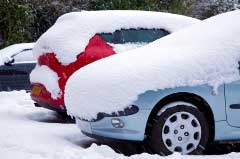Driving tips for upcoming winter - Vol.15
When planning a winter trip, include car care in your plans. Unless your car is brand spanking new, bring your car to your mechanic for a thorough check up. Have all the fluids changed, filters replaced, belts and hoses inspected and replaced if necessary, tires checked and properly inflated and windshield wipers inspected. Make sure the heating system and defrost works and the battery is in good shape. Check the spare tire and make sure it is in its proper place and fully inflated.
Have an emergency kit in your car that includes: flashlight with extra batteries, jumper cables, first aid kit, warning devices, blanket, snow shovel, ice scraper, snow brush, sand or salt, chains for the tires, tow chain, a can of dry-gas, a battery operated radio and extra batteries, an orange bandanna or flag, winter hat and gloves, food, emergency phone numbers for the area you will be traveling in and a jug of water. Always have your insurance information and registration handy.
Keep an eye on the weather and heed the weather reports. Delay your trip if possible. Always let someone know your travel plans and planned route. Check in with those folks from time to time so they know you are okay. Keep your gas tank at least half full to avoid the possibility of gas line freeze.

If you run into weather problems and must stop, stay with your vehicle, unless you are in front of a motel. It will provide shelter from the storm and make it easier for the authorities to find you. Pay attention to street signs and landmarks. If you have to call for help, you want to be able to tell rescuers where to find you. Tie the orange bandanna or flag to your antennae. If you car has an interior antenna, put the orange cloth in your window. Make sure snow or ice isn't blocking your exhaust pipe to avoid carbon monoxide from building up. Wrap yourself in your blanket to help stay warm. With cell phones today, calling for help is easier than it was in the days before mobile phones.
When driving on snow or ice, take your time. Accelerate and decelerate slowly. Jack rabbit stops and starts will cause skidding and accidents and not necessarily in that order. If you are on an incline, don't stop if you can avoid it. If you are approaching a red light, keeps your car rolling even if it is a half mile an hour. When the light turns green and you can go, it will be easier to accelerate slowly. If you stop, you may spin your tires for a while before moving forward. When you do have to stop on ice or snow, apply the brakes slowly, slowly, slowly. If you do get out of your car to put down sand or salt or even shovel, make sure your car is in park and parking brake is on. Do not stand in front of or behind the car if you can avoid it. There is always the possibility your car will begin to roll.

If you are driving in a snow storm, keep the defrost cranked up and the wipers wiping. You want to be sure your visibility is as clear as possible. If you have a rear window defroster or wiper, be sure that is keeping the rear window clear. If necessary, stop and clear the windows with snow.
If you do get stuck in the snow, don't panic. Turn your wheel from side to side several times to clear the snow away from your tires. Slowly press the gas and ease forward. If you spin your tires, stop. Try rocking your vehicle back and forth. Shift from forward to reverse and back to forward again. Do that until you can get going. If the weather reports are bad and you really don't have to go anywhere, play it safe and stay home.